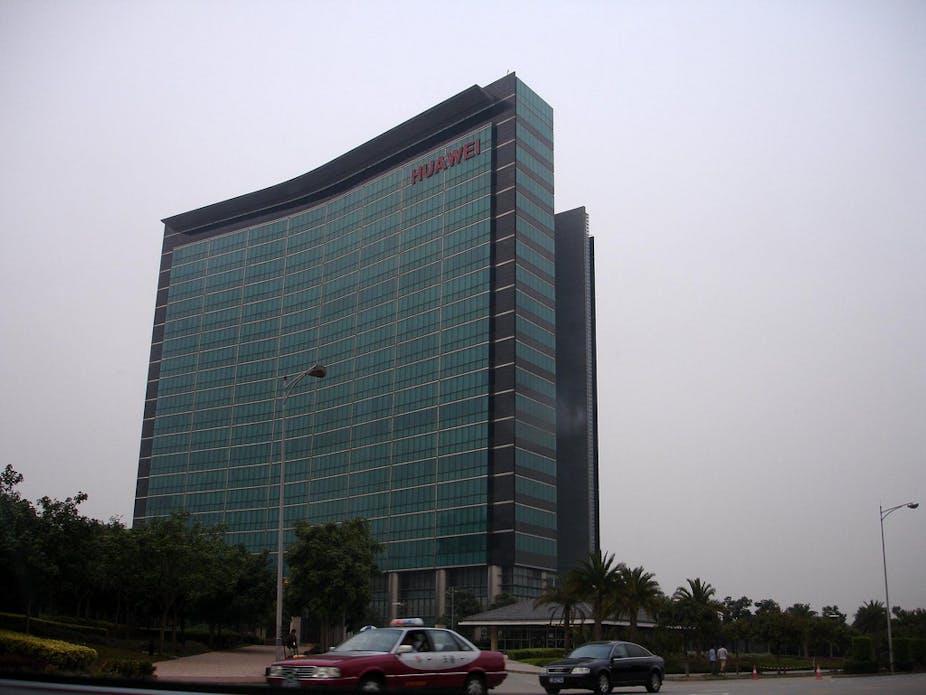Up until last week, many Australians were probably unaware of Chinese telcommunications company Huawei. But the decision by the federal government to ban Huawei from any involvement in the National Broadband Network has shone the spotlight on the company and its remarkable rise to prominence.
Despite the ban, Huawei has flagged that it is still keen to supply technology for the NBN. Yesterday, the chairman of Huawei Australia, John Lord, said that the company believes there are “parts of the NBN that are still suitable” and that “[Huawei’s] future in Australia is long term”.
Huawei is only 25 years old, but it has already achieved significant success. It is China’s largest innovator, one of the world’s top-three patent applicants, and a global leader of information and communications technology. Originally a very small company, Huawei now supplies top-quality products and solutions in over 140 countries, serving more than one third of the world’s population.
Last month, Ren Zhengfei, founder and president of Huawei, was ranked #1 on Fortune China’s list of the “50 Most Influential Business Leaders in China”. However, Ren remains China’s most mysterious business leader. For many, Huawei’s rapid expansion is similarly mysterious. How has it been growing so vastly, reaching over US$32 billion of annual sales in 2011?
Pathway to success
Huawei focuses on customer-centric innovation, the lifeblood of all technology companies. This can explain why a technology company - in spite of being in the world’s manufacturing centre, which has a weak capacity for innovation - has been successful in highly competitive top-end markets in developed countries.
To understand Huawei, it is important to understand the time and space in which Huawei and Ren have operated.
Huawei was established in 1987. This means it belongs to the early generation of post-1978 Chinese companies established after Deng Xiaoping’s open-door policy. Some of these early-generation companies have become very successful. In addition to Huawei, companies such as Lenovo and Haier are also successful overseas, including in Australia.
After the Cultural Revolution, China was an economic backwater. Companies like Lenovo and Huawei shared a common spirit of working hard from scratch, a spirit truly needed in that era. Huawei people, both managers and employees, used to work in a small office that also served as kitchen and dormitory. These modest origins were shared by Huawei’s first branches in Europe, where they started with just two employees in 2000.
In 1997, Ren visited a few US multinational corporations, including IBM. He later on mentioned his sentiment of the huge gaps between Chinese and Western companies. For Western companies, 1997 was on the eve of a new millennium. But for China, it was only five years into its post-1949 market economy.
Aiming at meeting international standards, Huawei immediately set about transforming itself. But how could Chinese companies operating at the bottom of the global value chain possibly challenge multinationals that dominate the higher end? For Chinese companies, factors such as capital, innovation and standards were almost non-existent.
From 1996 to 2000, Huawei made a concerted effort to promote itself at numerous international expos. It engaged IBM, at a substantial cost, to be its technology-training provider. In total, Huawei spent over US$150 million on its transition. Today, many Chinese companies do not want to pay a cent for such a necessary surgery.
There are other reasons, which cannot be disconnected from this specific historical context. When we look at Huawei today, it has certainly become renowned for its high-quality output, while many other Chinese companies have not.
Does Huawei’s rise mirror China’s re-emergence as a global innovator?
Huawei’s rise signifies China’s re-emergence as a global innovator. I use the term re-emergence to remind readers that for many centuries, China had been the world’s largest innovator; that China had been the world’s strongest economy was indeed underpinned by its high-technology-driven products, such as silk and porcelain. It was an era of “designed and made by China”, where China was the synonym for the finest quality.
This tradition had declined since the mid-17th century and was almost ruined during the Cultural Revolution, where knowledge was classified as counter-revolutionary. In recent years, China has sped up in creating comprehensive strategies to boost domestic innovation and attract overseas Chinese intellectuals to return to China. By 2020, China has signalled that it wants to become a leading player in innovation.
Many critics are unaware of this historical context and, perhaps, feel threatened by the scope of China’s ambitions. Soon after the Australian government’s objection to Huawei’s bid for the NBN, the Symantec-Huawei joint venture was also dismantled, over similar fears over the possibility of cyber-attacks and espionage linked to Chinese authorities.
If we understand China’s historical and cultural ins and outs, then Huawei’s rise is simply an example of China reconnecting itself to its past, where China was a peaceful global innovator.
As for Australia, it is important not to be fearful. Instead, it must strengthen its own innovation capacity by collaborating with Chinese scientists and engaging with a diverse range of Chinese investment opportunities to ensure continued economic prosperity.

